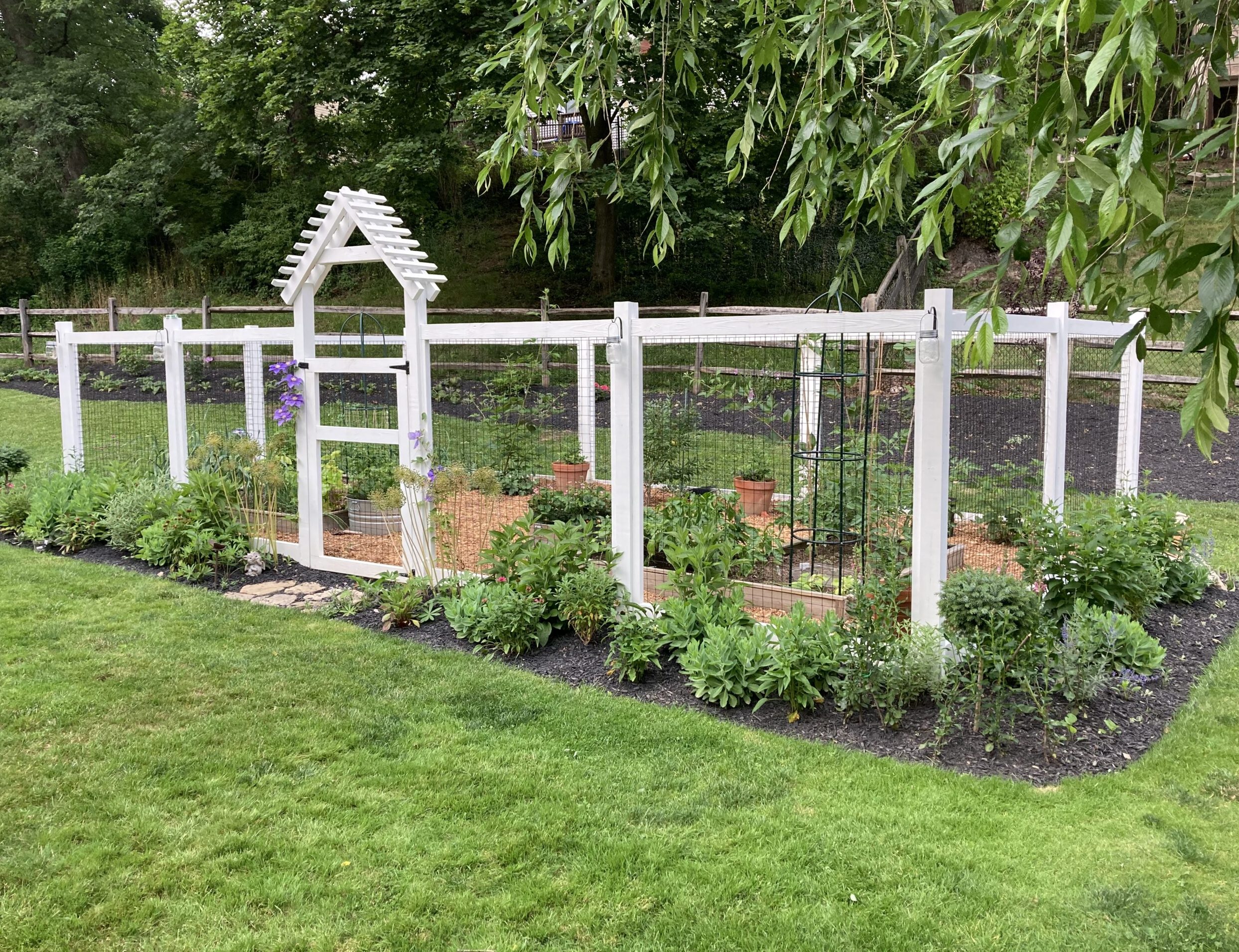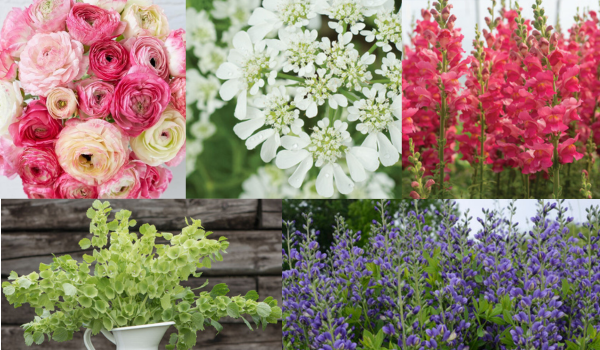Snapdragons From Seed For A Cutting Garden
Growing snapdragons from seed is an incredible way to have loads of gorgeous, spike blooms for your very own cutting garden!
Starting a cutting garden in my own backyard has brought me more peace and joy than I ever could have imagined. And if you’re new to starting a cutting garden, then I highly encourage you to start snapdragons from seed this year. They are so gorgeous and elevate any bouquet they are in.
Why Grow Snapdragons from Seed for a Cutting Garden
Snapdragons play a pivotal role in floral bouquets as a spike element. No other flower (except double flowering stock…LOVE!) can compare for a spike element quite like snapdragons.
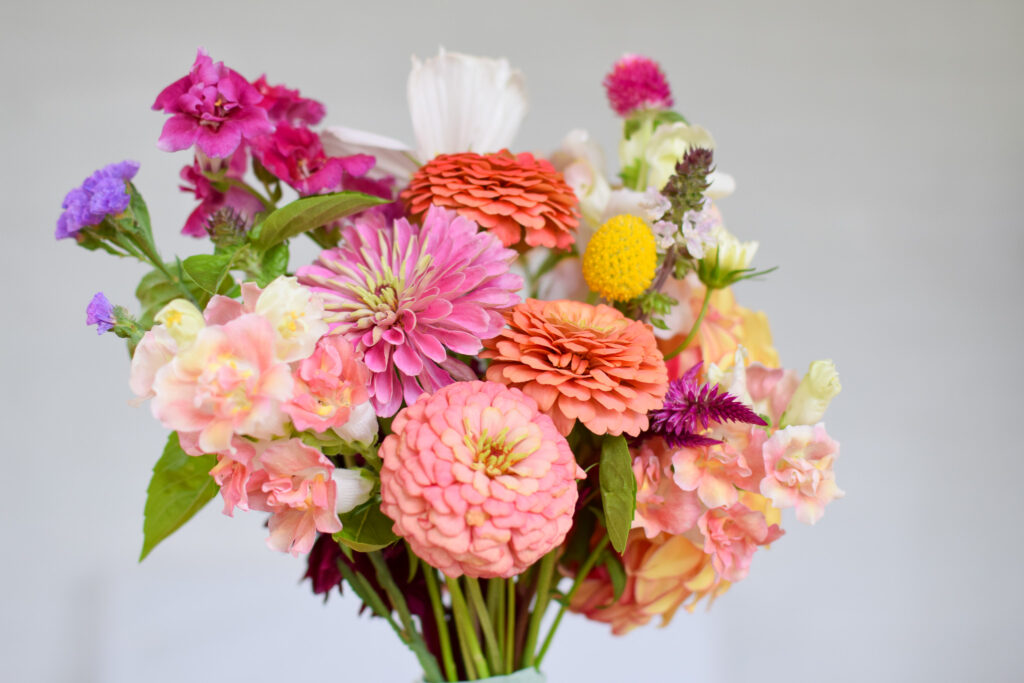
What’s great for home gardeners is you can buy snapdragon seeds specifically bred for bouquets. They come in loads of colors, bloom types and bloom times. The most common bloom time being spring and fall. Snapdragons are a hardy annual and can be started 12 weeks before your last frost, and planted out 6 weeks before your last frost.
When you grow snapdragons from seed indoors at home, you can start the seeds in the winter under grow lights and be ready to plant out the seedlings at the beginning of spring when there is still frost at night.
Snapdragons thrive in cooler weather. When they are planted out early (6 weeks before your last frost) you can get long, strong stems of beautiful flowers long before the summer flowers bloom. In zone 6, Pittsburgh, PA, I can have snapdragons blooming in mid June. I’m hoping for early June this year if all goes well!
Soil Blocks or Seed Trays to Start Snapdragons from Seed
The quick answer – – soil blocks. If soil blocking is new to you, check out this post where I walk you through it.
This year I started snapdragon seeds with soil blocks and seed trays. The soil blocks and balls have grown a far healthier plant. They are greener, more robust, and slightly bigger, too.



The poor seedlings in the seed starting trays are root bound and stressed. That’s why they’re more yellow than green. But the snapdragon seedling in the soil block ball is healthy, green, growing, and not root bound.
Both were started on the same day with the same seed starting mix. They’ve only been fertilized once (not my strong suit) and watered regularly. Soil blocks for the win!
If you are new to seed starting indoors, I strongly encourage you to start with soil blocks. Don’t even waste your money or time on seed trays. Each year I’m becoming a bigger believer in soil blocks and balls (I make soil balls in my hand to pot up small soil blocks). If you are just starting, I recommend soil blocks. If you have a stock pile of old seed starting trays (like me) I encourage you to stop buying more and start transitioning over to soil blocks.
How to Grow Snapdragons from Seed Indoors
Growing snapdragons from seed is fairly straightforward, much like most other hardy annuals.
Snapdragons are teeny tiny seeds and need light to germinate. This means we don’t bury the seeds like we do for other plants.
With snapdragons being a super tiny seed, you have 2 options for how to start them.
Option 1: Soil Blocks
You can use your utmost patience to take the tiny seeds for the snapdragons and place 1 seed on each soil block.
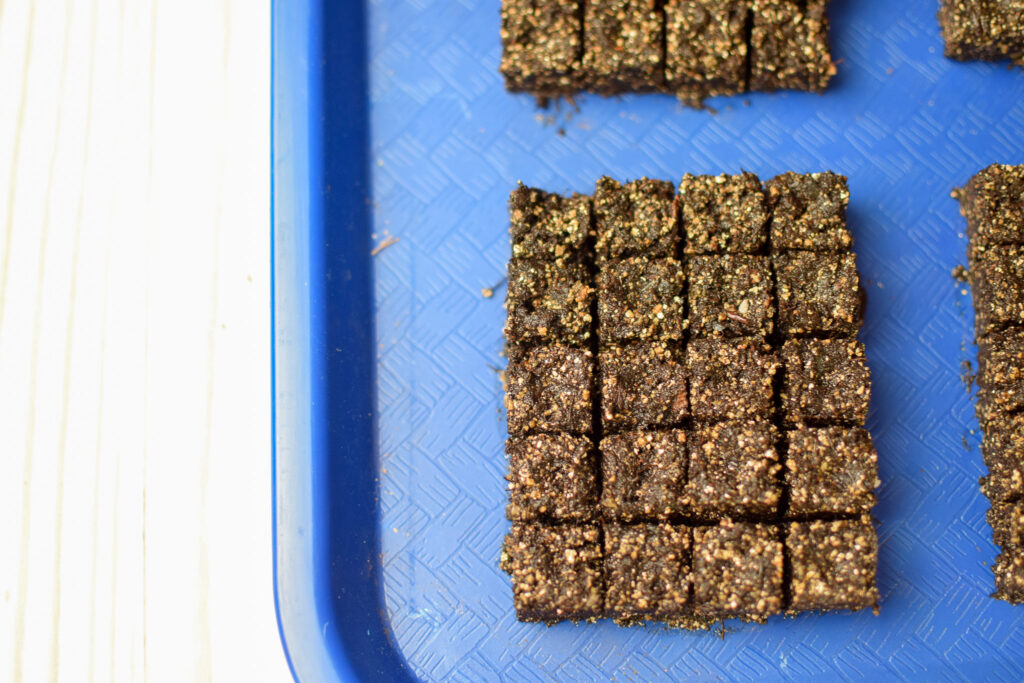
Don’t cover the seed with soil as they need light to germinate.
Spray with a mist of water to settle the seeds into the starting mix and cover with a humidity dome.
Mist the seeds with water 1 or 2 times per day to keep the seeds moist until they germinate in 7-14 days.
Keep the tray under lights for 14-16 hours per day.
When the seeds have germinated, it’s time to take that small soil block and pot it up to a bigger soil block.
Or you can make a soil ball by hand. Simply take the seedling and add more seed starting mix to it and form a larger ball around the soil block. If the ball doesn’t hold together, add more water to your mix. It should be plenty moist.
Grow on for several more weeks.
Option 2: Broadcast
Tiny seeds are kind of time consuming. When I have to start a large batch of small seeds, I like to broadcast the seeds over a small tray (I reuse Chinese takeout trays) of moist seed starting mix.
Take any water tight tray, fill it with about 1-2″ of moist seed starting mix and tamp it down so the soil is firm, but not hard. Spray the top with a bit of water.
Next, gently sprinkle the tiny snapdragon seeds over the moist seed starting mix. Mist again with water and then cover with a lid, but don’t seal it.


The picture above is how I utilize a takeout container for quick and easy seeding. The seeds in this picture are actually lettuce. Snapdragon seeds are tiny black seeds.
When the seeds germinate, pluck out the seedlings and pot them up into soil balls. Here is a quick video to help.
Keep your seedlings under grow lights for 14-16 hours per day.
Grow on for several more weeks.
How to Grow On Snapdragons from Seed
So your seedlings are a month or two old. Yay! It’s time for a trim!

Your seedlings should be several inches tall and have 3-4 sets of true leaves.
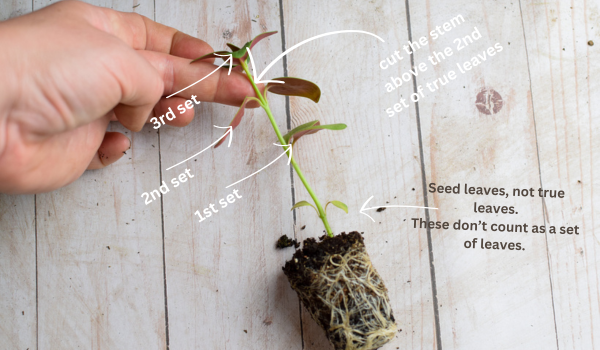
In the picture above you can see a snapdragon seedling with 3 sets of true leaves. The first set of leaves are actually the seed leaves. Those are the leaves you saw first when the seed germinated. We don’t count those as leaves as they belong to the seed and not the snapdragon plant.
Look above those tiny leaves and count the number of true leaves. If you have more than 2 sets (a set has 2 leaves, 1 on each side of the stem) of leaves, and your seedling is about 3-4″ tall, it’s time to pinch.
How to Pinch Snapdragons
Pinching your snapdragons sounds scary. We’re going to snip off the top leaves to create side branching.
When we cut off that leader, the plant will send out 2 more shoots. This gives you twice the amount of flowers. It does delay blooming by a few weeks, but it’s worth it!



If you don’t pinch, you’ll end up with 1 strong, gorgeous flower, and maybe a few weakling side shoots. I pinch 95% of my snapdragon seedlings and leave a few just so I have some early blooms.
You can see in the picture below how these pinched snapdragons are now sending out 2 more shoots where the old stem was cut off just a couple of weeks earlier.


The first year or two you pinch your seedlings may be rough…at least it was for me. I was horrified hacking my little babies down. But now I have no mercy! I love whacking the tops off knowing what’s in store for me in just a few more weeks!
Full disclaimer: I still feel like a murderer pinching dahlias. Cutting the tips off of dahlias hurts. But I push through it for the greater good of more blooms!
When to Plant Snapdragons Outdoors
Snapdragons, and all other hardy annuals, can be planted out 6 weeks before your last frost. My last frost is May 15 so I always aim to get my hardy annuals out of the house by April 1 (just in time to start the summer annuals!).
But don’t just chuck them outside! You need to harden off all plants that are grown indoors.
Imagine laying in the blazing sun at the beach for 12 hours after being stuck inside all winter. Your skin would fry. The same is true for plants.
Indoor plants need to acclimate to the outdoors. They’ve never seen the sun! Grow lights are not the sun.
I like to take a semi-cheater way of hardening off plants.
Day 1
I like day 1 to be a cloudy day. Put the seedlings outside for about 1 hour with little sun.
Then bring them back indoors and put them back under the lights.
Day 2
Leave your plants out for 2 hours and then bring them back in under your lights.
Day 3
Find a protected spot against your house or near a wind break and leave your plants out for half the day. Make sure it’s a semi-cloudy day with no rain.
Then bring them back inside under lights.
Day 4
Place the plants in a protected spot where they can only get about 4 hours of sun and the rest of the time is in the shade. Leave them out until you remember to grab them.
Then bring them back in under lights.
Day 5
So this is where I am a super cheater. If I make it 4 days, I roll with it.
On day 5, the plants go back to their protected spot and they stay out there for several days.
Then I’ll move them to a sunny spot until I get them in the ground.
You are supposed to take up to 2 weeks to introduce your seedlings to the outside world, increasing the time little by little.
I just don’t have the time or patience for that. My cheater way has worked for me for 8 years. I encourage you to do what feels right and is also feasible for your life.
When time allows I plant the snapdragons in a sunny spot as deep as their little soil blocks. If they are root bound (half of mine are) try to loosen those roots and fan them out when planting.
Tips for Growing Snapdragons from Seed
Spacing:
Space snapdragons 6-12″ apart in the ground or in raised beds. I find 6″ is plenty.
The plants are for cutting so the excess flower stems won’t be on the plant for long. I have limited space so I plant close and have had success with it.
Staking:
Snapdragons are geotropic – – they will always bend in an upwards position even when gravity pulls them down. What this means is when a strong wind knocks them over at night, the next morning you will have an entire patch of snapdragons shaped like L’s. The stems were lying horizontally on the ground and so the plant bent itself back upwards. Once the bend is there, it stays.
To prevent this bending, use horizontal netting to support the flowers. I like to install the netting at the time of planting. Keep it taught so the weight of the flowers doesn’t cause the netting to collapse.
Harvesting:
Snapdragons are beautiful! But don’t wait until all the flowers are open. Cut the stems when the bottom 1/3 or 1/2 of the flowers are open.
You want to cut the stems deep into the plant, about 2-3 leaf sets above the ground. Cutting deep encourages the plant to pump out long stems again.
Place cut stems in a tall bucket that can support the length of the stem. These plants will bend even after being cut. So make sure to keep them supported in water for several hours after cutting.
Leave the flower stems in the water for several hours in a cool location to “condition”. This means the stems get to rehydrate after being cut which helps their vase life.
Vase Life:
Snapdragons last about 1 week in a vase. If you never change the water (guilty) you can still get about 5 good days.
Snapdragons from Seed for the Backyard Cutting Garden
If you love fresh cut flowers, bouquets of flowers spring through fall, and/or gifting flowers, then snapdragons are a must for your garden!
These aren’t bedding plants. These tall gorgeous flowers are perfect for vases and arrangements. No one will believe you’ve grown these yourself. Snapdragons look like florist quality flowers…because they are! But these bad boys can be grown in your own backyard for just a few dollars!
I hope you try growing snapdragons from seed this year. I’d love to know what you think in the comments below.
Thanks for stopping by!


